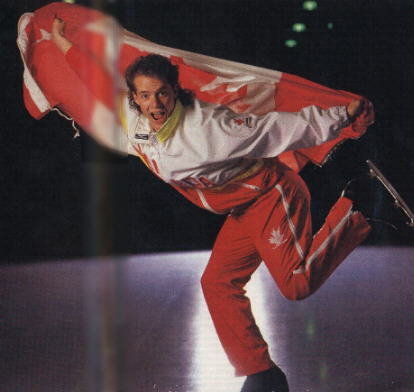|
The split-second skill of a figure skating prodigy: Kurt Browning. (1989 Maclean's Honor Roll)
| Source: |
Maclean's, v102 n52 p38(2). |
| Date: |
December 25, 1989 |
| Author: |
D'Arcy Jenish and Brian Willer |
Full Text COPYRIGHT Maclean Hunter Ltd. (Canada) 1989
THE SPLIT-SECOND SKILL OF A FIGURE SKATING PRODIGY

He was introduced to thousands of Canadians, in 16 cities across the country
this fall, as "the amazing Mr. Kurt Browning, the 1989 Men's World Figure
Skating Champion." Usually, a single spotlight illuminated his solitary figure
slumped over a wood-and-metal chair at centre ice. The moment the upbeat music
began, Browning was up swirling, soaring, leaping. During his two-minute
routine, he was a mesmerizing punk in a black leather jacket, white shirt,
fingerless gloves and blue jeans. He performed a triple jump, a backflip and
his trademark quadruple jump. Everywhere he performed, as a star of the
Champions on Ice touring show, Browing was showered with prolonged applause.
In part, those performances were warm-ups for the 1990 world championships in
Halifax in March, where Browning aims to become the first Canadian male ever
to win two consecutive world figure skating titles. But they were also simply
expressions of the joy of skating, which Browning says that he feels when he
is flying free before a crowd.
Still only 23, his enthusiasm has helped him to compile an impressive list of
victories. He captured the Canadian novice, junior and national championships,
a feat previously achieved only by Brian Orser, the 1987 world champion. Then,
in March in Paris, Browning became the fourth Canadian in 78 years to win the
men's world title. Despite his artistry, he acknowledges that men's figure
skating is so competitive that any of the top five skaters in the world can
capture the crown. But he insists that he loves the pressure and intensity of
world-class competition. "I have an inner confidence in myself that says if
I'm the best I can be, I will probably win," he says.
When he is not competing or touring, Browning spends 5 1/2 hours a day on the
ice at Edmonton's Royal Glenora Club, training under coach Michael Jiranek and
choreographer Kevin Cottam. There, he practises his quadruple jump, the
spectacular, split-second move that Browning was the first to perform in
competition. The entire action, including the jump, four revolutions and
landing, takes only eight one-hundredths of a second to complete. "If my
takeoff is right, I know it will be a sweet jump," he says. "It's like hitting
a tennis ball with the sweet part of the racket."
Browning began to learn about the sweet feeling as a boy in Caroline, Alta., a
town of 450 people in the foothills of the Rocky Mountains 130 km northwest of
Calgary. He learned to skate at age 6 on a backyard rink flooded by his
father, a hunting guide who is now retired. Until he was 15, Browning was a
slick, high-scoring centre in minor hockey and he took up figure skating to
improve his hockey skills. He gave up hockey to avoid injury and because
figure skating had become too time-consuming. But he still combines his power
as an athlete and a competitor with his gifts as an entertainer.
Browning, who lives in Edmonton with his older brother, Wade, and likes dating
women he meets in the skating world, regards training as work. When he steps
onto the ice for a competition, he says that he feels he is on vacation. "I
love being in front of a crowd," he says. And the crowds have come to love
him. After every appearance with the Champions on Ice, the skater was mobbed
by teenage girls for autographs. Now, whether he wins or loses in Halifax, the
many people who have thrilled to his skill know that Kurt Browning has already
elevated the sport of skating to exciting new heights of artistry.
|

